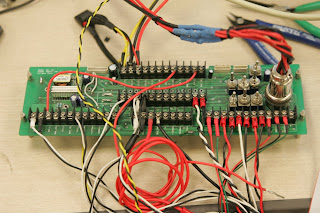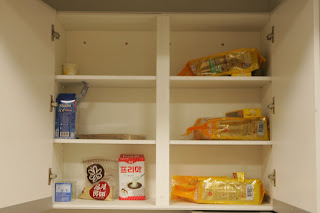

The main parts bins. For anyone who might be planning a lab in the near future, this is
the example to follow. It's hard to see in the pictures, but there is a stock of every part you could ever actually use. Furthermore, all the part bins are labeled, sorted, and logically arranged.
The soldering station where I work is well equipped, if unremarkable. All of the circuit boards, from IMU to motor controller, are custom. As such, they have 10's of different blanks in stock, as well as enough solder to plumb a city. In-house technicians do the majority of the assembly (both mechanical and electrical parts), freeing up some of the students time to focus on design and experiment. The sheer volume of components in even 1 HUBO necessitates this arrangement.
Unfortunately, SMD components are a pain to both store and use. There are 5 or 6 blue trays devoted to standard size resistors, capacitors, LED's, and ICs. Due to the lack of desk space, however, you have to keep shuffling the trays to find what you need. A better approach for common boards is to fill the tray with all the parts necessary for that board. That way, assuming someone keeps inventory, you can work quickly and efficiently.
Even with the inventory on hand, assembling a board is laborious. To properly solder a microprocessor, for instance, you have to carefully line up all of the pins, tack a few in place without disturbing the chip, then heat and solder the rest. Since there are no flux pens, they coat all of the pins in an unsightly wad of solder, and remove the extra with the iron and a lot of paste flux. You get a clean joint, though you pay the price in harsh headache from the fumes. Small components like transistors, caps, and resistors are much simpler, but you still have to properly solder every joint, which means close inspection, eyestrain and...you guessed it...pounding headache after an hour or so.
The technicians make production possible; without them, students would spend hours assembling and checking PCBs. Even more so than HUBO, DASL can't afford that tradeoff without technicians. While we must have the ability to quickly repair and refurbish a damaged board, we still need to buy finished boards whenever possible to save time.

The part to the left is the perfect example of why you need the right tool for the job. To disassemble this harmonic drive, I had to remove the sun gear deep in the body. 6 heavily thread-locked cap screws held it in place. Lacking T-handle hex drivers, the technician suggested using the ball-end allen key. I couldn't communicate my doubt, since he spoke little English, but he demonstrated by removing 4 of the screws without incident. When he torqued the remaining two, however, the heads stripped. My satisfaction was brief, though, since now I had to remove two partially stripped screws from a very expensive part. After finding a bench grinder, I ground the ball off an old key. In that time, he had painstakingly drilled and chipped out one of the screws. The second one popped loose after a nervous twist of my modified key. Simply having a $30 set of T-handle hex drivers would have saved the fuss and the subsequent retapping of damaged threads.
 The "brains" of hubo are this little PC: A mini-ITX board running an 800MHz Pentium-III. Power is drawn from the distribution board shown below, which can run from any DC source.
The "brains" of hubo are this little PC: A mini-ITX board running an 800MHz Pentium-III. Power is drawn from the distribution board shown below, which can run from any DC source. 














